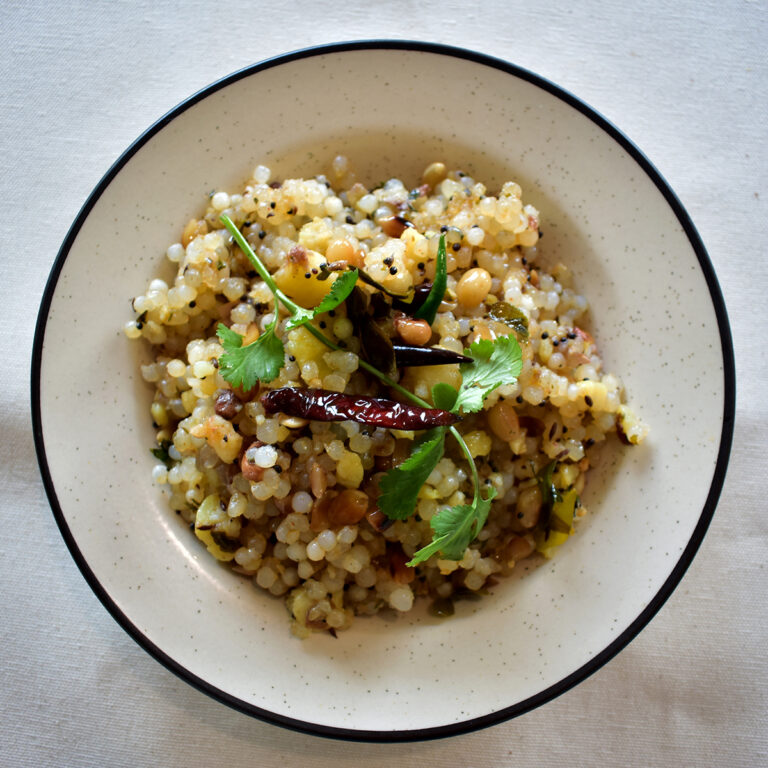Sabudana (Tapioca Pearls) Khichdi
Sabudana Khichdi is a popular Indian dish from Maharashtra, a state in the north-west part of India. Sabudana has a wide variety of health benefits attached to it. So indulge yourself in some healthy sabudana Khichdi and enjoy it for breakfast or as an evening snack.
While sabudana is a popular dish during the religious fasting days of the year in India, the healthy ingredient is gaining widespread popularity as a super food because of its multiple health benefits. Also known as tapioca pearls or Sago, it is a good source of protein which helps with muscle building, healing and strengthening. Other than bringing a lot of protein to the table, tapioca pearls are rich in iron and calcium which helps maintain bone health. It won’t be wrong to call it a magic ingredient as it is loaded with carbohydrates and therefore has the power to make you feel energetic in a matter of minutes. All this has made it a popular ingredient among all the health freaks and gym enthusiasts as well.
- Times
- Description
- Image
- Ingredients
- Method
- Notes
- Nutrition
View Print Layout
- Prep time: 10 minutes
- Cook time: 15 minutes
Ingredients
- 250 g sabudana
- 50 g raw peanuts
- 2 tablespoon oil
- Half teaspoon cumin
- Half teaspoon mustard seeds
- A handful of curry leaves
- 2–3 green chilies, chopped or slit
- 2–3 whole red chilies
- Two medium-sized potatoes, boiled and cut into small cubes
- Salt, to taste
- Black pepper, to taste
- 1 tablespoon lemon juice
- 2 tablespoons coriander leaves
Method
- 1)
Put the entire quantity of sabudana in a white bowl
- 2)
Add 2–3 cups of water to the bowl and rub the sabudana with your fingers. Repeat this step 4-5 times till all the extra starch gets removed from its surface and the water runs clear.
- 3)
Soak the sabudana for at least 5-6 hours or overnight. This depends on the kind of sabudana you are using. Some varieties turn soft quickly while others take some time. After complete soaking the become almost double in size.
- 4)
Press a few sabudana pearls between two fingers. If soaked properly, the pearls will be soft and will get mashed easily.
- 5)
Drain the pearls completely using a strainer.
- 6)
In a pan dry roast the raw peanuts until they are crunchy. Let them cool down for a while. Once cool down remove their skin and grind the peanuts coarsely.
- 7)
Ground peanuts will coat the sabudana and keep them separate, avoiding a mushy dish.
- 8)
Heat 2 tablespoon of any oil, add mustard and Cuman. Once they begin to splatter add a handful of curry leaves, dry red chilies, chopped green chilies and sauté for 2–3 minutes.
- 9)
Add boiled and cut potatoes and sauté for two minutes. Add salt and other spices.
- 10)
On a medium flame add soaked sabudana pearls and the crushed peanuts.
- 11)
Mix everything well and cover the pan for 3-4 minutes. Just check once they turn transparent in colour. This shows that they are done.
- 12)
Remove the pan from the heat. Add coriander leaves and lemon juice.
Serve it warm.
Variations :
- 1)
You can add coconut pieces and ginger as well.
Notes
- Rinsing the sabudana pearls well is the most important step as it helps to get rid of the excess powdery starch on the surface of the pearls which makes sure that the pearls don’t stick to each other after they’re cooked.
- Soaking the pearls in fresh, cold water is the next most important step.
- Soak the pearls in just enough water to immerse them. Soaking the pearls in a lot of water will over soak them and they will eventually become sticky after they come in contact with heat.
- Draining the water from the pearls is optional (but recommended). We. Draining out the water ensure that there is no excess moisture left.
- Cooking the pearls for a longer time makes them sticky and they will form lumps. The pearls need to be cooked for just 2-3 minutes. As soon as they turn translucent, you know they’re cooked.
- Use a heavy bottom pan so that the khichdi doesn’t stick to the bottom of the pan.
- Add lemon juice as it helps the pearls to not stick together.
- Adding sugar will also make the khichadi sticky.

